Upgrading the Server/Client/FEP Station Using the Semi-Automatic Installation
Scenario: You have acquired the software distribution for Desigo CC containing all the required folders including
- Brand,
- EM folder with the required extensions along with their EULA and other required files/folders, for example, PostInstallation folder containing post-installation steps enabled
- GMS folder containing Languages and Prerequisites folders along with other required files including the post-installation step for LicenseActivatation enabled
- Instructions folder containing one or more GMS Platform.xml file for the setup type that you want to install along with all the required extensions, their external paths, if any and their post-installation steps enabled, if any, in order to execute them
(Optional) For setting up the local web server (IIS) on the installed setup type, the value of the tag ConfigureIIS = True is configured and enabled in the selected GMS Platform.xml file. Otherwise, set the value of the as False.
- (Optional) Languages folders for additional language packs
- (Optional) Upgrades folder with subfolders EP and SR containing required files including files for EMs and their Languages, SR patch and its languages
- Gms.InstallerSetup.exe.

NOTE:
During a silent or semi-automatic installation/upgrade, if a Desigo CC EULA or EM EULA is accepted in an XML file, it automatically accepts the EULA. In this case, it is mandatory to hand over the EULA as a file or printout to the end customer and ensure the acceptance of the EULA, duly signed by the end customer.
You want to upgrade the existing installation (V4.0/V5.0) for the Setup type – Server/Client/FEP using the semi-automatic installation mode. You also want to add new extensions (along with their post-installation steps, if any), new language packs or new installation language. Furthermore, you also want to configure web server (IIS) on the already installed setup type during upgrade process.
Additionally, the routine post upgrade activities such as license activation, project upgrade, HDB upgrade, website and web app upgrade and the Client launch can also be executed during the upgrade process as part of the post-installation steps execution. Furthermore, along with the already installed extensions, the new extensions along with their post-installation steps, if configured, are also installed and executed as a part of the upgrade process.
This workflow describes upgrading the Desigo CC Server. However, you can use the same workflow to upgrade the Setup types - Client or FEP. Ensure that for Client/FEP installation, select the modified GMS Platform.xml file, available at the path ...\InstallFiles\Instructions, containing setup type as Client or FEP and the extensions along with the post-installation steps that can be installed on the Setup type - Client/FEP.
Reference: For background information, see the reference section.
Workflow diagram:
Prerequisites:
- As specified in the upgrade roadmap, you have referred to the planning checklist.
- Verified and backed up the existing installation.
- Obtained and verified the software distribution setup.
- Completed the Upgrade Planning Requirements including installing .Net 4.7.2.
- Verified and enabled the GMSPlatform.XML file.
- Enabled the required post-installation steps for execution.
- Acquired the administrative rights on the system where you are performing the semi-automatic installation.
Steps:
- Select the Gms.InstallerSetup.exe file located in the InstallFiles folder from your local drive and double-click to run. Do not install the software directly from a USB drive as this increases the time it takes to install Desigo CC .
- From the InstallFiles directory, double-click Gms.InstallerSetup.exe.
- If your UAC settings are set to Default or Always Notify, a User Account Control message may display, asking if you want to allow this installation program to make changes to the computer. Click Yes.
- A error message may display, if the operating system is not supported by Desigo CC . Click OK to abort the installation. Click View Log to open the log file, which informs you about the supported operating systems.
- A confirmation message may display if the installation, uninstallation, or repair of another program is in progress. To continue with Desigo CC installation, click Yes. Otherwise, wait for the program to complete its installation, uninstallation, or repair by clicking No and rerun the Gms.InstallerSetup.exe file.
- The Installation Selection dialog box is skipped when for a setup type only one instruction file is present in the Instructions folder and there are no inconsistencies in the distribution media or GMS Platform.xml file and the
ShowSystemRequirementtag in the GMS Platform.xml file is set toFalse.
- The Installation Selection dialog box displays only when there are multiple instruction files in the Instructions folder or when there is a single GMS Platform.xml file present for a setup type and there are inconsistencies either in the distribution media or in the GMS Platform.xml file or that file has
ShowSystemRequirementtag set toTrue.
- In the Installation Selection dialog box, that displays, proceed as follows:
- Verify that the computer has all listed software installed before clicking Next otherwise, a message displays.
- Even if there are files present for multiple Setup types, the previously installed setup type is selected by default and you cannot modify it.
- If multiple files are available for selection, then select the required file for upgrading the installed setup type from the listed files.
NOTE: Any mismatch between the GMS Platform.xml file and the software distribution is listed in the Warnings section. (See Consistency Check Scenarios).
- If all the files in the Instructions folder are corrupted, then they are not available for selection and the Next button is disabled and you cannot work with semi-automatic installation. The Customize button is enabled and displayed only when one of the files available in the Instructions folder contains the value for the tag Customize = True.
For any consistency issues regarding the distribution media, for example, platform (GMS folder) or EM folder, including the post-installations steps, a warning message display in the Installation Selection dialog box and you can view details by clicking View Log. For more information see, Consistency Check Scenarios.
- (Optional and required only when you want to install and configure IIS on the installed setup type) Verify that the checkbox for IIS configuration is selected. The checkbox displays only when no IIS component is installed on your machine. Thus, the configuration of IIS settings are automated only if when they no IIS settings are configured already. However, if any IIS component is already installed, a warning message displays informing you to manually configure IIS. (see manually install and configure IIS on the Server/Client/FEP computer).
If all required IIS components are already correctly installed and configured, an info message displays and you can proceed with installation.
- Click Next to proceed with the semi-automatic installation.
If you clicked Customize, you proceed with the custom installation.
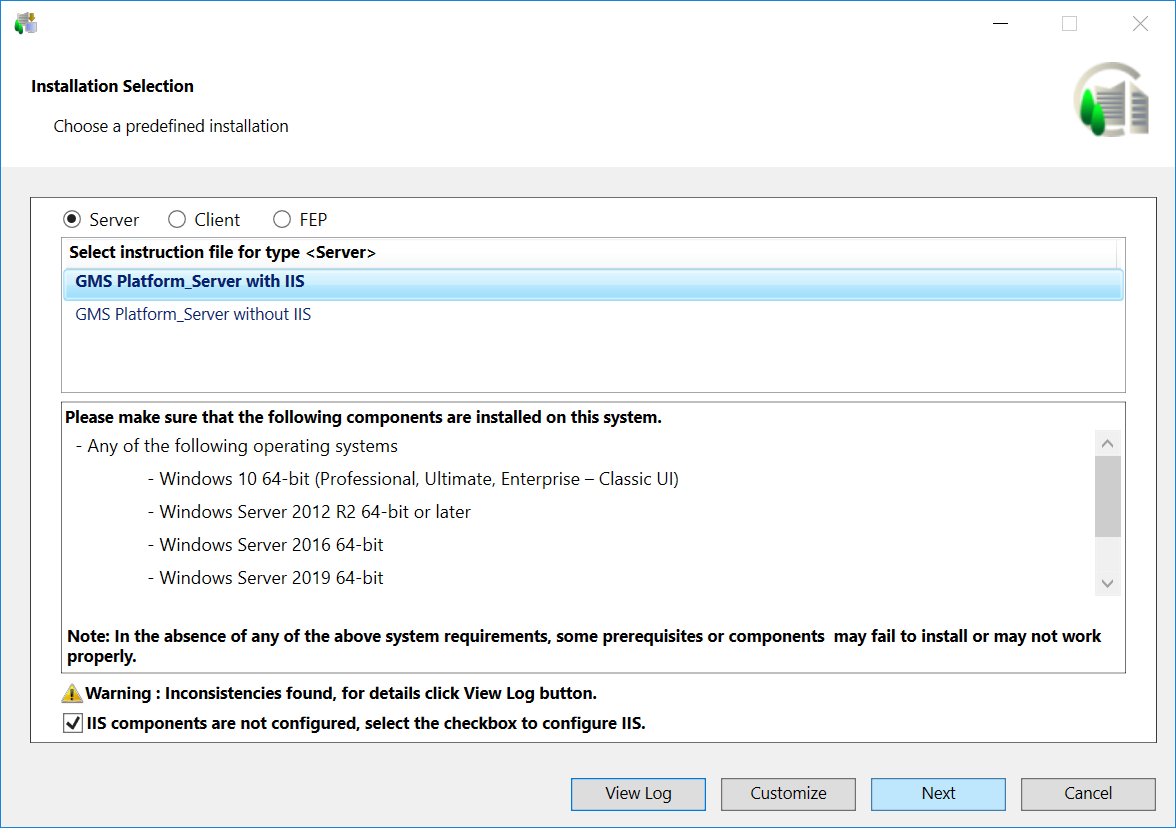
- By default, the installation language configured in the GMS Platform.xml file is used for installation. However, if the language pack is invalid or not found on the distribution media, then the Welcome to the Desigo CC Upgrade Wizard dialog box displays, with the default selection as the en-US language or the current OS language. It also lists all the languages whose language packs are valid and available at the path
...\InstallFiles\Languages. You can also add more installation languages using Add Installation Language.
- Click Next.
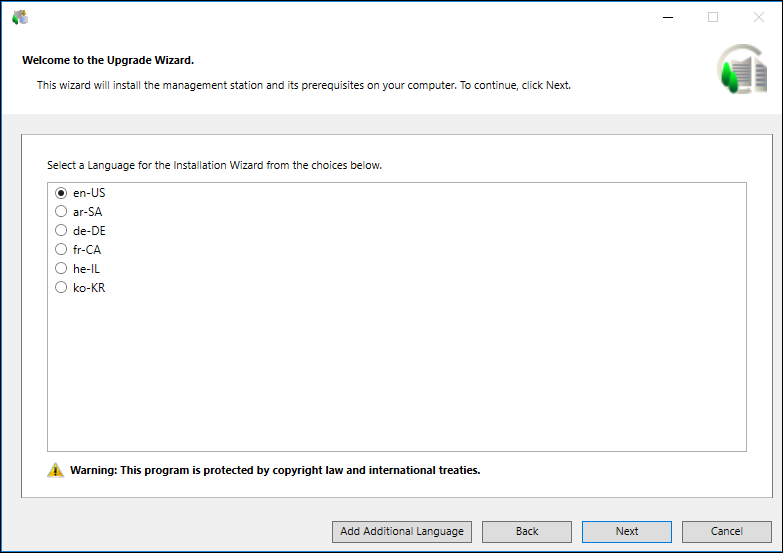
- By default, all the previously installed extensions along with their post-installations steps, if available in the media are upgraded. Along with that all the extensions that you have configured in the GMS Platform.xml file also get installed during the upgrade process.
However, if there is any inconsistency in the configured extension (for example, the configured extension is inconsistent) or in the post-installation step (for example, the configured post-installation step is not available in the [GMS/EM Name]PostInstallationConfig.xml file) then the Feature Selection dialog box or the PostInstallation Steps Selection dialog box displays, assisting you in selecting the extension or the post-installation step. For more information see, Consistency Check Scenarios.
- Additionally, you can also add an extension from the location other than the distribution media using Add EM. It should have a valid folder structure ....\EM\[EM Name]. Ensure that the parent extension of the newly selected extension is also selected. Otherwise, the newly selected extension (child) cannot be added and a warning displays.
It also automatically adds the extension suite for the selected extension, if the extension suite is not listed. If Languages folder is kept parallel to the EM folder, the Installer automatically detects the Language packs for the external extension to be added and add it.
If there are missing extensions during upgrade using semi-automatic installation then the Next button is disabled in the Feature Selection dialog box. You must add the required extensions in order to proceed with the upgrade.
- Click Next.
NOTE: If the already installed extension is not available in the software distribution then error displays and you cannot proceed with the installation.
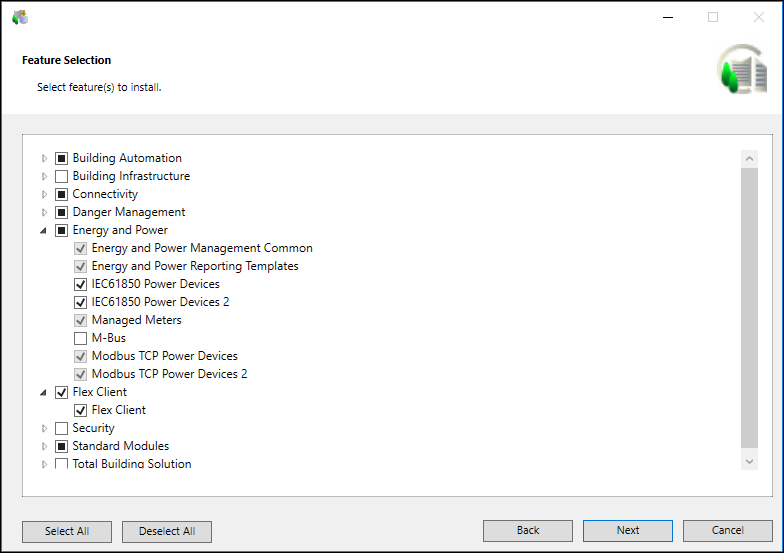
- By default, all the previously installed languages packs, if available in the distribution media, are upgraded. Along with that all the new language packs that that you have configured in the GMS Platform.xml file also get installed during the upgrade process. However, any inconsistency in the GMS Platform.xml file with respect to Language Pack Name (for example, the LanguagePackName entry is missing or the language name is invalid) or with the Language Pack (for example, Language Pack not present in software distribution), results in displaying the Language Packs dialog box, where all the already installed language packs are selected and disabled, by default, thus not allowing you to modify them.
NOTE: Make sure you install only required language packs and extensions, as it adds to the total disk space. All required language packs must be installed before you create a customer project. (See Language Packs and the List of Supported Languages)
- Click Next.
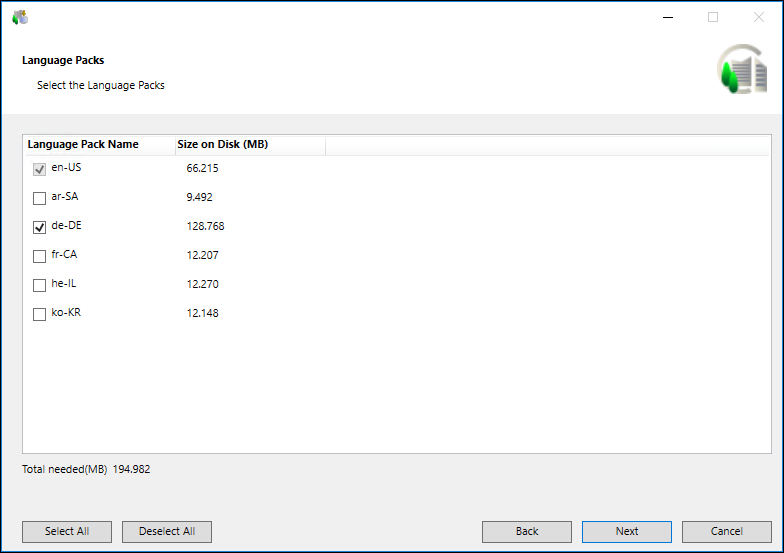
- By default all the previously installed prerequisites are upgraded by default, if they are available in the distribution media. At the same time the prerequisites, listed in the
<SkipInstallation>section are skipped.
NOTE: The prerequisite, listed in the<SkipInstallation>section, for example Microsoft SQL Server 2019 - Express Edition, is skipped only when the valueAskUser = 1andMandatory = 0is configured in the GMS/EMConfig.xml file.
The Prerequisite Version Selection dialog box only displays when there is any conflict with the installed prerequisites and the<AutoResolvePrerequisiteConflict>is set toFalsein the GMS Platform.xml file. It lists the required versions of the installed prerequisites and recommends you to install the required version, if the installed version is not compatible.
If you have already installed V3.0 or V4.0 with SQL Server 2014 Express edition, you do not need to uninstall it. During upgrade Installer upgrades it to the latest version, SQL Server 2019, Express edition (except for on Windows Server 2012 R2).
However, in V3.0 or V4.0 if you have skipped the SQL Server 2014 installation during installation or used your own SQL Server, still in V3.0/V4.0 required SQL Client components prerequisites are installed. Now, during upgrade, Installer upgrades to required SQL Server 2019, Express edition and installs/upgrades required SQL Client components prerequisites.
You can also skip SQL Server 2019, Express edition. Note that the required SQL Client components prerequisites are still upgraded/installed.
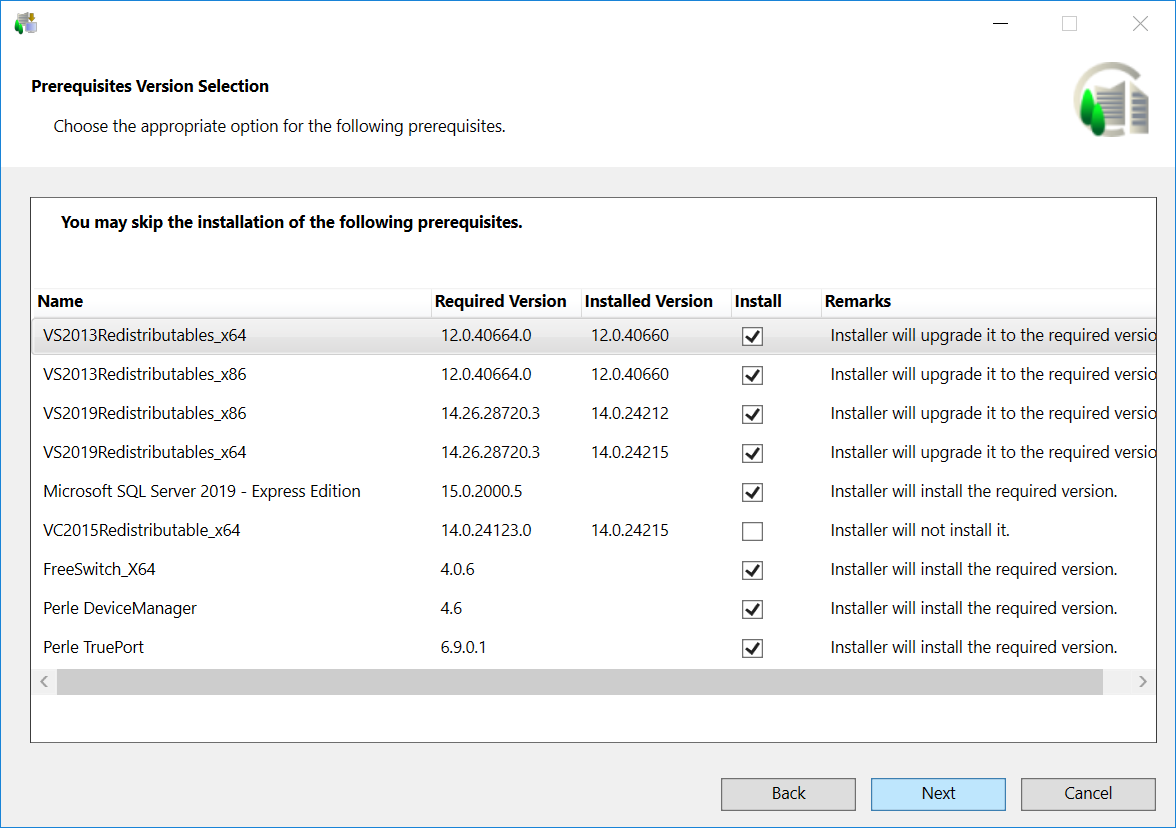
- Click Next.
- If the disk space required for the selected setup type installation on the selected drive and the temporary disk space required only for the time of installation (always calculated only for the system drive), is less, then the Installation Folder dialog box displays. You cannot change the path of the installation.
- Click Next.
NOTE: If a negative number in red displays in the Remaining Space field, then Next is unavailable and a warning message displays. You must re-run the setup after making the necessary adjustments in the available disk space. (See Tips to Free Up Disk Space).
- If any inconsistency exists with the EULA entry in the GMS Platform.xml file (for example, EULA entry missing) or with the EULA file (for example, EULA file missing in the software distribution), the License Agreement dialog box displays.
- Accept the terms of the license agreement by selecting Agree for each license that you want to install and then click Next.
- Click Next to display the Ready to Install the Program dialog box listing the status of the prerequisites, Desigo CC installation, extension modules installation, help merging status, and the status of the post-installation steps that you selected for execution and status for those which are executed mandatorily.
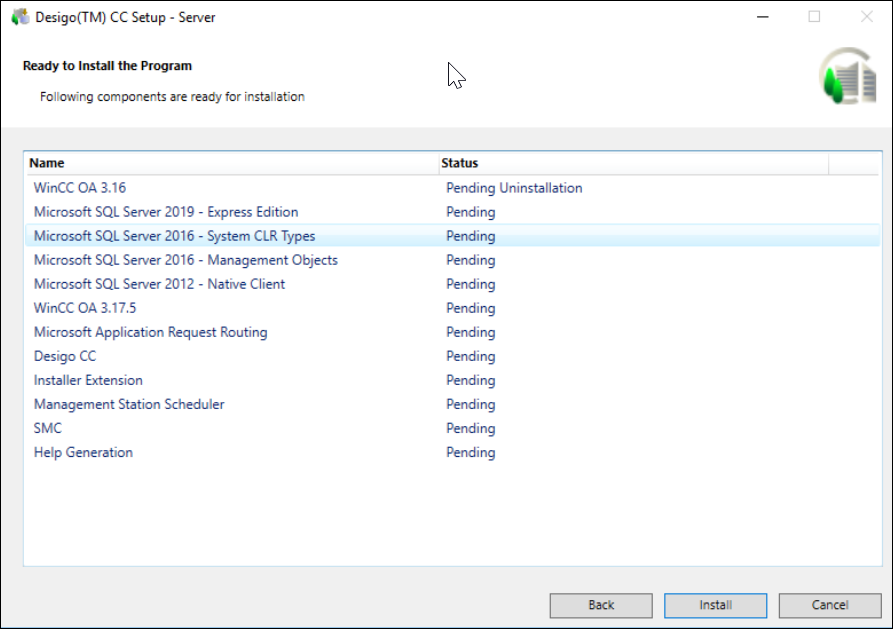
- Click Install. This can take a few minutes as the Installer installs the listed prerequisites and any extensions.
- If a mandatory prerequisite fails to install, a message displays and the Desigo CC Installer aborts the installation process. However, if a non-mandatory prerequisite fails to install, the installation process continues and notifies you about the failure at the end of the installation process.
- A message box may display asking you to restart the computer. Select to restart to continue the installation. After restarting, depending on the Windows UAC settings, if the Installer Wizard does not start automatically displaying the Ready to Install the Program dialog box, then you must restart it manually by double-clicking Gms.InstallerSetup.exe, or get approval from IT to change the UAC settings. (See Changing User Account Control Settings).
- After the IIS installation, the Installer also installs Microsoft Application Request Routing (ARR) also listed in the Ready To Install the Program dialog box.
If you disable IIS configuration, ARR does not install.
- A message may display if a process (installation, uninstallation, or repair of another program) is in progress notifying you that you must complete the ongoing process before installing Desigo CC.
- When the installation program is complete, the Installation Complete dialog box displays.
- Click Close to complete the installation.
NOTE: In case of any installation errors, such as failure in installing prerequisite/extension/language pack, click the View Log button to open the log file and view the details of the errors (see Description of Installer Error Codes).
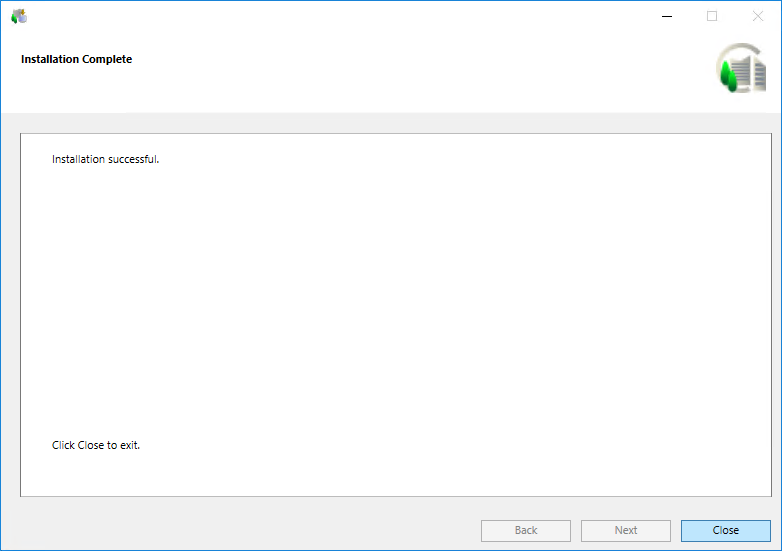
- The selected setup type server/server with web server (IIS) installation is successful. The currently logged in user is added as a member of the IIS_IUSRS group.
The default website deleted from IIS manager and hence does not display in SMC.
The post-installation steps, if available, for the platform or installed extensions are executed.
- (Optional and applicable only for post-installation step – License Activation) The licenses are upgraded and activated based on the license files (.lic) available and/or Activation/Entitlement IDs specified. You can verify license activation of these files in LMU.
For already active licenses, expired licenses, invalid file format or missing files, and so on a message displays:Installation Successful but with some errorsin the Installation Complete dialog box. In this case click View Log that displays in the Installation Complete dialog box to open the Installer ELog file located at the path [System drive]:\ProgramData\[company name]\GMS\InstallerFramework\GMS_Installer_Log.
- (Optional and applicable only for post-installation step – Project Setup) The already existing active project is upgraded, activated and started by default. If the History Database was linked to the previously active project, it is also upgraded along with the Long Term Storage, if any and then all the existing web sites and web applications are also upgraded, even if upgrade of the any of the existing web application fails. The already existing certificate is used for securing the communication between the Windows App client and the web server (IIS).
Finally displays the logon dialog box for specifying the credentials.
If there is no already existing project, HDB and website/web application available for upgrade, then the JSON file is referred to for the creation of the project, History database and website/web application. Note that even if the HDB creation/upgrade fails, the post-installation continues with the next step. In that case, you can re-run the post-installation step for HDB creation/upgrade.
For the configured an existing project’s Pmon user/web application user, if the password is expired then the web application upgrade fails and you must manually update the web application using SMC. For more information, refer to the SMC log at the path
[Installation drive]:\[installation folder]\GMSMainProject\log.
- (Optional and applicable only for post-installation steps of other extensions) The post-installations steps of other extensions, when correctly configured, enabled (modified the .txt file to.xml) are executed as well successfully.
